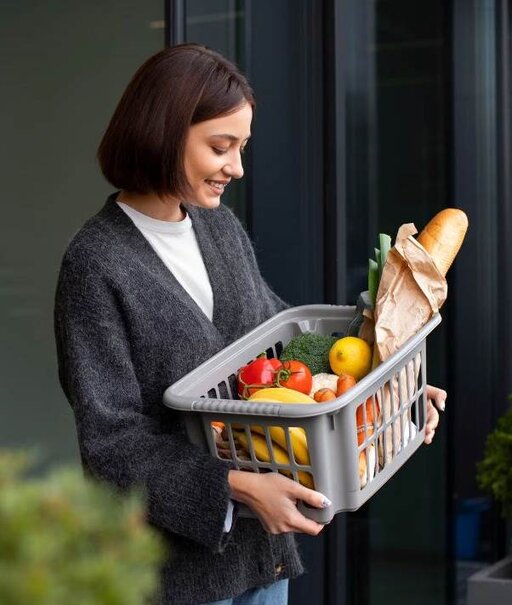Brian Taylor
VP of Transportation Solutions at Kaleris
Digital transformation isn’t about chasing new tech. It’s about fixing the everyday problems that slow you down and turning your supply chain into a real competitive advantage.



Amid intense competition in the retail grocery sector, effective supply chain operations can be a key source of competitive advantage. From discount chains to national hypermarkets and regional powerhouses, grocers are realizing that manual logistics processes and outdated – or absent –technology can’t keep up with today’s demands. Digital transformation isn’t about chasing the latest trend, it’s about solving real problems and supporting daily operations.
How can retail grocers turn digital disruption into a competitive advantage? Drawing on real-world insights from leading grocers, here is a practical, 7-step guide from supply chain expert Kaleris to evolve from outdated supply chain processes to optimized store replenishment.
Step 1: Assess Your Current Operations
Action:
Step 2: Making the Case for Change
Action:
Action:
Action:
Every upgrade begins with an honest evaluation. Between stores and warehouses, disconnected systems, piles of paperwork, and inconsistent routines slow things down. Delays add up, mistakes get made, and staff end up spending time on avoidable issues.
Assemble a small team to walk through your logistics process. Where do things slow down? Where are you spending more than you planned? Make a list of pain points, big and small. That’s the foundation you’ll build from.
Step 3: Connect Your Systems
Step 4: Automate, Automate, Automate
Digital tools are investments. With strategic selection, short-term ROI can cover costs and lay the groundwork for future savings. Not every logistics process can be fixed overnight, so focus on improvements that will have the biggest impact for your specific challenges, such as:
- Route optimization to reduce miles driven and fuel consumed
- Automated carrier rate comparison and performance score-carding
- Load and labor optimization to maximize trucks, drivers, and warehouse staff
Set measurable goals such as cutting fuel costs, reducing overtime, or speeding up delivery times. Track progress and use results to prove the value of change. One warehouse-style value chain started using the Kaleris Grocery Logistics Suite auction feature to have carriers bid on one-off inbound deliveries, which ended up saving them $700,000 annually and hundreds of hours previously spent manually contacting carriers.
Disconnected logistics nodes lead to inefficiencies – deliveries arrive before docks are ready and trucks idle in the yard while paperwork is sorted. When systems don’t communicate, time and money are lost.
Connecting and streamlining essential logistics activities is imperative to bridge these gaps and requires systems specifically designed to accomplish this, such as these solutions in the Kaleris Grocery Logistics Suite:
- Transportation Management Systems (TMS) designed for the grocery industry that optimize trailer loading and delivery routes as well as load assignments, backhauls and driver hours of service.
- Yard Management Systems (YMS) which coordinate inbound and outbound trailers, dock scheduling, and live monitoring to minimize dwell times that cause spoilage and prevent congestion.
In-app reporting and analytics: Delivers real-time, enterprise-wide visibility of transportation and yard activities, enabling teams to act on comprehensive KPIs and alerts that prevent bottlenecks.
Choose technology that connects transportation, yard, and store operations. One Kaleris customer, a large regional grocer, used to manually transfer data between separate TMS and YMS systems. When a status change occurred in one system, their team had to track it down and update the field in the other system, causing confusion and errors. After adopting the Kaleris Grocery Logistics Suite, which connects the TMS and YMS, data flowed seamlessly, eliminating thousands of manual entries monthly, improving accuracy, and saving hundreds of hours.
Much of the daily grind in retail grocery logistics comes from repetitive, manual tasks: entering the same data in multiple places, chasing down paperwork, or double-checking trailer numbers and stats. Automation frees teams to focus on higher-value work.
Start by automating one recurring task, like route planning or dwell alerts. A southeastern supermarket chain automated route planning with Kaleris TMS, saving time for planners and drivers, reducing miles driven, and cutting equipment costs by over 10%. Monitor progress and track outcomes against KPIs, such as time saved, then expand by automating the next task.

Action:
Action:
Action:
Step 5: Protect What Matters Most
Step 6: Use Data to Improve, Not Overwhelm
Step 7: Keep It Moving
Make Every Step Count
Customer trust depends on fresh products, stocked shelves and reliable service. Technology helps monitor temperatures, track deliveries, and keep stores stocked, reducing waste and building confidence that you deliver on your promises.
Conduct a process audit to pinpoint where mistakes happen. Identify digital solutions tailored to grocery logistics, with capabilities that help keep food safe and deliveries to the store on time. One full-service supermarket chain lacked visibility into incoming deliveries and struggled with planning their replenishment crews. With the Kaleris Grocery Logistics Suite, store managers now have complete visibility to all incoming deliveries before they arrive. These stores often receive multiple deliveries daily, with larger locations getting up to four. With full visibility into incoming shipments, store managers can now easily plan their day while enjoying their morning coffee. Teams also reported higher job satisfaction thanks to how the digital solution reduced daily chaos and confusion.
Numbers should help you spot problems and make better choices, not add more work. Simple in-app dashboards or reports can highlight late shipments or inefficient hand-offs.
Start with a daily report of top logistics issues. Use it in team meetings to discuss what worked and what didn’t, then adjust quickly.
Technology changes, and so do customer needs. The goal isn’t one big leap, but regular, meaningful improvements. Each upgrade should solve a real problem and make daily work a little easier.
Review your logistics operations regularly to assess performances and spot new challenges. Select a technology partner that understands grocery retail and offers scalable, flexible solutions to keep your supply chain moving forward.
Digital transformation is about practical, incremental improvements that help teams work smarter and deliver better service. Whether your focus is low prices, freshness, or variety, embracing digital operations is both essential and a unique opportunity for competitive advantage.
By taking a disciplined, stepwise approach focused on measurable results and unified execution, you can move beyond legacy limitations and build an agile supply chain that sets your brand apart. The journey requires effort and mindset shifts, but the rewards are clear: fewer exceptions, lower operating costs, stronger customer loyalty, and a supply chain that becomes your greatest differentiator.
If you’re ready to optimize your store network logistics, the Kaleris Grocery Logistics Suite is designed to make the most of your digital transformation journey. Learn more at www.kaleris.com today.

About Kaleris
Kaleris is a global software company solving the world’s most complex supply chain transportation challenges. Trusted by over 680 companies across 97 countries, Kaleris provides mission-critical software for yard and transportation management, terminal operations, and ocean shipping. By building a more connected, visible, and reliable global logistics ecosystem, Kaleris bridges the data and operational gaps that create inefficiencies and empowers customers to achieve their goals. For more information, visit www.kaleris.com





